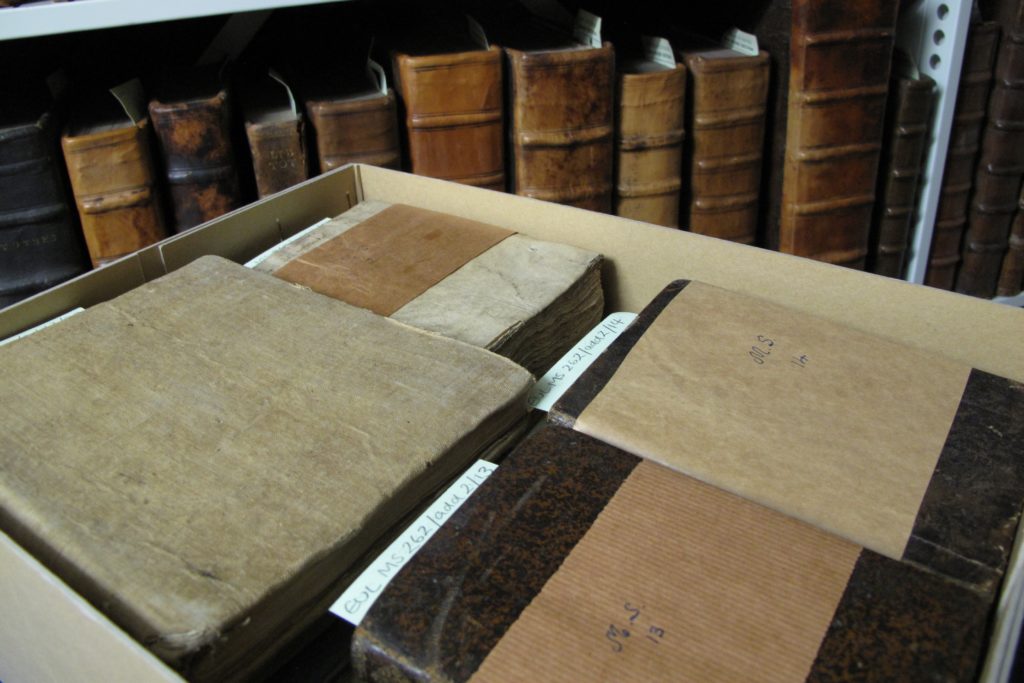Following the completion of the Syon Abbey archive cataloguing project, I have been left with a little time before my next project to turn my attention to some enchanting and intriguing items in our collections: modern manuscripts in the Syon Abbey Medieval and Modern Manuscript Collection (reference number EUL MS 262).
In 2004, twelve medieval and early modern manuscripts were deposited with us for safekeeping, and these have remained some of the most popular items in our collections, both in the reading room and in teaching here at the University. Three subsequent additions to the manuscript collection since 2004 have increased the number of manuscripts to 191 bound volumes and 8 folders of unbound papers. These additional manuscripts have always been open to users, but they have only been accessible through scanned lists in PDF files, which provide limited detail and are not searchable. In an endeavour to improve their discoverability and accessibility, I was delighted to devote two magical weeks to cataloguing the manuscripts at item level.

As the manuscripts were accessioned or transferred to the manuscript collection as three separate additions, they have been catalogued as three distinct sections. I have renumbered these as EUL MS 262/add1, EUL MS 262/add2 and EUL MS 262/add3. But never fear! I have made a note of the previous reference numbers in the catalogue entry for each item, so if you have accessed one of the manuscripts before, you will still be able to find it on the catalogue by entering the old reference number in the search box.
The section numbered EUL MS 262/add1 comprises handwritten, typewritten, and a very small number of printed items that were kept by the community on a bookshelf at their last place of residence in South Brent, Devon. To improve access, these manuscripts have now been rearranged into an approximate chronological order, but a list of the items in their original order exists and is available on request. The section numbered EUL MS 262/add2 consists of 28 manuscripts that were previously listed as part of the Syon Abbey archive, and the majority were kept in a box marked ‘Box 28’; 24 of these manuscripts were numbered 1-24 by the community at Syon Abbey and entered into a notebook labelled ‘Register of Syon Manuscripts’. Finally, three early modern manuscripts that were previously kept in the safe by the community at Syon Abbey make up the third section, numbered EUL MS 262/add3.
The newly-catalogued manuscripts were created or collected by the community over the course of five centuries, with the earliest manuscript dating to 1526 (EUL MS 262/add3/1), and the most recent dating to the late twentieth century (EUL MS 262/add1/143). In addition to the theological, liturgical, and devotional manuscripts that one might expect to find in a monastery, the manuscripts also include several histories of Syon Abbey, personal accounts of the lives of sisters, and notes on the contents of the library. The majority of the manuscripts are in English; however, the collection also includes manuscripts partly or wholly written in Latin, Portuguese, French, Dutch, Spanish, Swedish, German and Italian. Intriguingly, many of the manuscripts include the names of the nuns or monks who transcribed or read them, providing fascinating insight into scribing and readership at Syon Abbey. I’ve included images of extracts from some of my favourite manuscripts (it was so hard to choose!) in the slideshow below.
[slideshow_deploy id=’651′]
The manuscripts are now fully-catalogued and available to browse in our online catalogue. To see all the catalogue entries for the manuscripts at once, simply enter EUL MS 262* into the ‘Ref No’ field on the ‘Advance Search’ page to view all the catalogued manuscripts. And don’t forget – we also look after the printed books from the Syon Abbey library and the recently catalogued Syon Abbey archive, as well as several other Syon Abbey related collections.
Happy browsing, reading and exploring!
By Annie, Project Archivist